Recaro has been in the racing business for decades and the car seat business for a number of years now, and have gradually been expanding their line from quality booster seats to convertibles and infant seats. The Recaro Performance Coupe is their newest infant seat, and when I was offered the chance to review one, I couldn’t pass it up. You can buy the Recaro Performance Coupe here, and keep reading to see whether it lives up to its “performance” moniker when it comes to keeping kids safe and comfortable and parents happy and stress-free. From a company with a history in racing, I had high expectations.
2017 update: There haven’t been any significant changes to the Recaro Performance Coupe in the last two years in terms of rear-facing weight or height limits; it remains pretty much the same seat as it was during my original review.
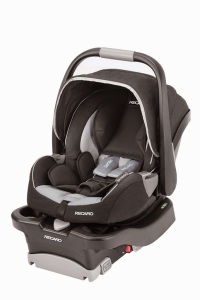 Recaro Performance Coupe – What’s the big deal?
Recaro Performance Coupe – What’s the big deal?
The Recaro Performance Coupe infant seat is touted as having a number of technologies designed to make riding in a car seat both a more pleasurable and safe experience for children, beginning with features like memory foam and temperature-sensitive fabrics and ending with side impact protection inspired by racing technology. It’s an infant seat, which means it’s designed to be used from day one when leaving the hospital, and that it will need to be replaced within the first 2 years of life, due to the size limits of the seat. It is also designed to rear-face only. Is it worth it? I think so. Let’s take a closer look at why in this Recaro Performance Coupe infant car seat review.
Recaro Performance Coupe Limits for Weight and Height
Rear-facing: 4 to 35 pounds. Children must be less than 32 inches in height and must remain rear-facing throughout the life of the seat. The seat also cannot be used if the child’s head is within 1″ of the top of the seat. Being an infant seat, this seat is not designed to enable children to rear-face until they’re 4, which is what I recommend. However, it will get you started, and parents should get at least 1 year out of it.
An infant pillow insert is included in the seat that is designed to be used between 4 and 11 pounds. There are 5 adjustable height positions for the harness and 2 buckle positions.
Buy the Recaro Performance Coupe on Sale with Free Shpping at Amazon here.
Dimensions of the Recaro Performance Coupe
The Performance Coupe is 18 inches high, 17 inches wide, and 31 inches deep. When installed with the base, it weighs 18.5 pounds, while when without the base it weighs 10 pounds. In other words, it’s a pretty beefy seat. It’s narrow enough, however, that you shouldn’t have any problem with 3 across car seat installations. You can check the 3 across guide to see what similar seats fit well in your vehicle.
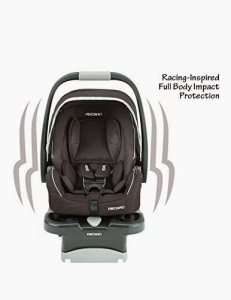 Using the Recaro Performance Coupe
Using the Recaro Performance Coupe
Out of the box, the Performance Coupe inspires confidence; it has a solid, rugged look to it, and it feels firm when held. It’s also quite a large seat. The seat has a number of features that, per Recaro, were inspired from racing safety research, including side impact protection that is designed to keep the entire body of the child shielded in the event of a side impact collision. Given the high rates of fatalities from side impact collisions, I’m a fan of the technology. EPS foam is included generously throughout the seat to help with force reduction and absorption. The side wings are deep and run the length of the seat.
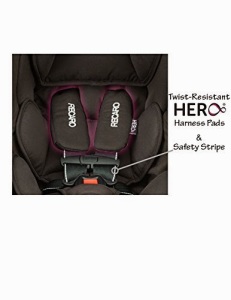 HERO harness technology is also included, which refers to a system for making the harness straps less likely to twist when being used. They aren’t twist-proof, but from my efforts to twist them, I’d definitely agree with Recaro’s assessment of their being twist-resistant. It’s designed to make the harness adjustment easier each time. A no-rethread harness is included, which is easy to adjust with one hand. Five positions are included for height, as well as 2 buckle positions, which is rather standard across most infant car seats these days.
HERO harness technology is also included, which refers to a system for making the harness straps less likely to twist when being used. They aren’t twist-proof, but from my efforts to twist them, I’d definitely agree with Recaro’s assessment of their being twist-resistant. It’s designed to make the harness adjustment easier each time. A no-rethread harness is included, which is easy to adjust with one hand. Five positions are included for height, as well as 2 buckle positions, which is rather standard across most infant car seats these days.
The HERO technology specifically works by keeping the shoulder pads at the child’s neck, shoulders, and head, while at the same time making harness twisting less likely and helping keep the chest clip in the right position. It’s also designed to make the seat more comfortable by keeping the harness straps away from a child’s neck due to its positioning of the shoulder pads in the harness.
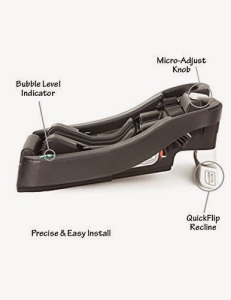 The Performance Coupe also includes cloud comfort memory foam, which is designed to take the shape of your baby over time. It’s similar to the foam used in memory foam mattresses, and it seems to do a good job in remembering the imprints left by babies sitting in the seat.
The Performance Coupe also includes cloud comfort memory foam, which is designed to take the shape of your baby over time. It’s similar to the foam used in memory foam mattresses, and it seems to do a good job in remembering the imprints left by babies sitting in the seat.
Percale fabrics are used in the seat cover, which are soft, well woven, and feel pleasant when touched. They are designed to balance temperatures felt by children sitting in them, in order to keep them from getting hot or cold easily. The cover itself is easy to maintain, as it is easily removable and can be cleaned quickly with a wet cloth. I particularly like that the cover can be removed and reattached without needing to rethread the harness, as is common in a number of cheaper infant seats. The canopy is large and can be set to multiple positions.
Installing the seat is rather straightforward, whether through seat belt installations or LATCH installations. You can install the seat by itself or with the included base. You can also buy extra bases to make installation easier in multiple cars, which I would highly recommend due to its allowing you to simply snap in the seat without disturbing a sleeping infant.
A micro-adjust knob is included in the base of the car seat along with a flip foot to help you find the right recline without resorting to rolled blankets or pool noodles. Specifically, the knob can be used to make small adjustments relative to the ground, while the quickflip recline is essentially a foot that you can activate in order to achieve a few extra inches of recline. I also like the inclusion of a bubble level indicator to help you make sure that you have the right level of recline dialed in.
Speaking of recline, the seat does a good job fitting my test 7 pound newborn doll, and is a seat I would expect to fit slightly smaller than full term babies as well. If you have a baby between 4 and 11 pounds, you’ll need to use the included infant insert.
The Performance Coupe may also be used with the Performance Denali stroller to form a complete travel system.
Buy the Recaro Performance Coupe on Sale with Free Shipping at Amazon here.
Why Buy the Recaro Performance Coupe?
For me, buying an infant car seat is primarily about safety, and secondarily about convenience. You want a seat that’s going to fit your children well and you want a seat that you’re going to want to use frequently. I find the Recaro Performance Coupe fits on both accounts. It’s designed to work from day one from the hospital and will fit your child until he or she is at least 1 year old. When your child begins to approach 1″ of the seat’s height, 32 inches, or the 35 pound weight limit, you’ll want to look into a convertible seat next so you can continue rear-facing until you reach 4 years of age or more, as rear-facing is the safest position for a child of any age when traveling in a motor vehicle, but this holds especially true for infants and toddlers. Don’t be in a rush to forward-face.
Besides the usefulness of the Performance Coupe from day one, I’m also a big fan of the side impact technology, the HERO harness technology, the ease of installation, the fact that it’s made locally in the United States, the multiple options for achieving a good recline, and the rugged feel of the seat. Drawbacks to the seat include the fact that it’s on the heavier end compared to some other infant seats. However, I’m also a fan of the memory foam and the sturdiness of the seat. I recommend the Recaro Performance Coupe infant seat wholeheartedly. You can buy the Performance Coupe here in Fern, Scarlet, Granite, Indigo, Onyx, Royal, and Candy. Canadians can buy it here.
—
If you find the information on car safety, recommended car seats, and car seat reviews on this car seat blog helpful, you can shop through this Amazon link for any purchases, car seat-related or not. Canadians can shop through this link for Canadian purchases.
 Who:
Who:

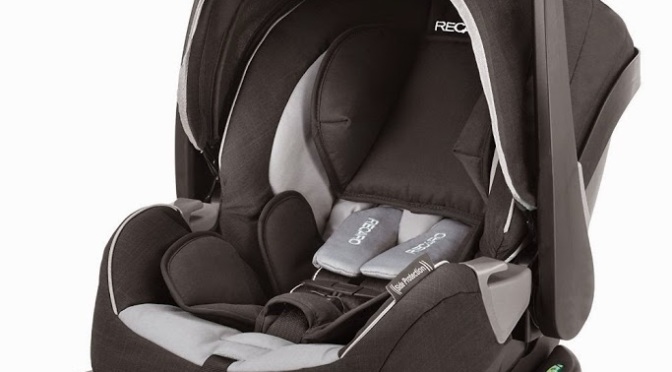




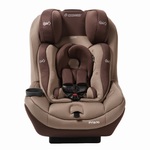
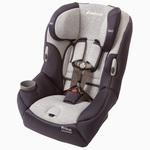

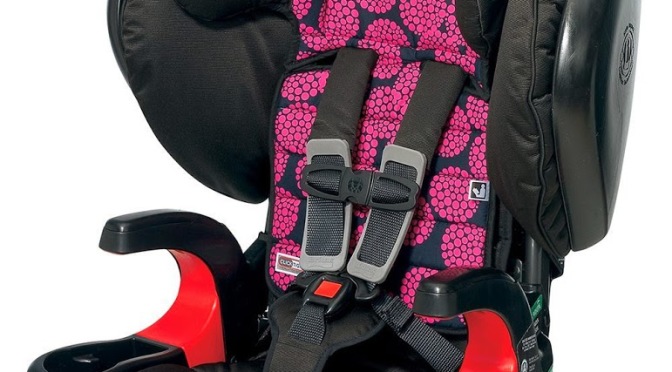
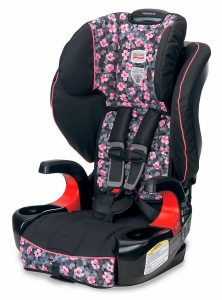
 If you find my information on best practices in car and car seat safety helpful, you can
If you find my information on best practices in car and car seat safety helpful, you can 
 Who:
Who: